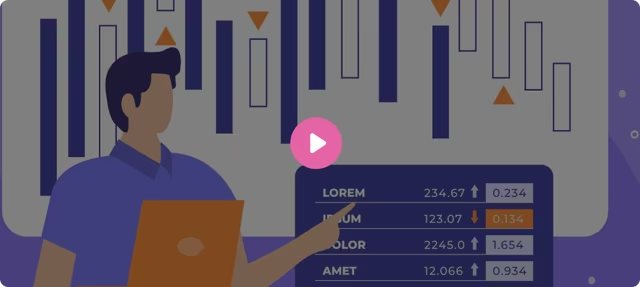 (1).png)

What is Open Interest in Trading?
A Key Indicator for Futures Traders on PSX
As you advance in your understanding of futures trading on the Pakistan Stock Exchange (PSX) through Azee Securities, it becomes crucial to grasp certain technical indicators that can significantly influence your decision-making. One such important concept is Open Interest (OI).
Whether you're trading stock futures or preparing for potential Options markets in the future, knowing how to interpret Open Interest can give you a deeper insight into market trends, liquidity, and investor behavior.
Understanding Open Interest (OI)
Open Interest refers to the total number of outstanding or active contracts—either in futures or options—that are not yet settled or closed. These contracts remain "open" until they are squared off by an opposing transaction or reach expiry.
For example, if one trader buys a futures contract and another sells it, one contract is created and counted in Open Interest. If later either party exits the position (by closing it with an opposite trade), that contract is removed from the count.
At any given time, Open Interest provides a snapshot of how many positions are live in the market, indicating the level of participation, liquidity, and market sentiment.
Note: In PSX, Open Interest currently applies to stock and index futures contracts. Options contracts are not yet available, but the concept remains applicable across both instruments globally.
Open Interest vs. Volume – What's the Difference?
Many traders confuse Open Interest with Volume. While both relate to trading activity in derivatives markets, they measure different dimensions of market behavior:
| Metric | Open Interest (OI) | Volume |
|---|---|---|
| Definition | Total number of active, unsettled contracts | Number of contracts traded in a day |
| Timing | Updated once daily, typically end of day | Live data, updates throughout the day |
| Indicator of | Market interest and trend sustainability | Market activity and participation |
| Value Type | Continuous data | Intraday aggregate data |
- Volume increases whenever a new trade (buy/sell) is executed, regardless of whether the contract is new or existing.
- Open Interest increases only when a new position is created and decreases when positions are closed or settled.
Understanding this difference helps traders determine whether a market trend is being supported by strong participation or not.
How to Interpret Open Interest in the PSX Futures Market
In the context of stock futures trading on PSX, Open Interest serves as a real-time indicator of trader commitments and confidence levels. Here's how traders often interpret OI patterns:
- Rising Price + Rising OI: This suggests bullish sentiment. New money is flowing into the market, supporting the uptrend.
- Falling Price + Rising OI: This usually indicates a bearish trend. Sellers are dominating, and more traders are taking short positions.
- Rising Price + Falling OI: This can signal a short covering rally. Existing short positions are being squared off, which may indicate a temporary rally.
- Falling Price + Falling OI: Implies long liquidation or profit-taking. Traders are closing long positions, which may lead to a further drop in prices.
At Azee Securities, our research tools and trading platform offer real-time OI data, helping clients interpret market strength or weakness before entering or exiting trades.
Benefits of Monitoring Open Interest
Tracking Open Interest, particularly at the end of each trading day, provides insights that can help forecast potential trend continuations or reversals. Here’s how:
- Identifies Strength of a Trend: A consistent rise in OI with corresponding price movement validates that the trend—upward or downward—is supported by increasing market participation.
- Signals Trend Reversals: A drop in OI despite ongoing price movement could indicate that the trend is losing steam and a reversal may be approaching.
- Gauges Market Liquidity: Higher OI usually means greater liquidity, allowing for easier entry and exit without wide bid-ask spreads.
- Detects Market Sentiment: Unusual spikes in OI may suggest aggressive positioning or speculative build-up, alerting traders to increased volatility or leverage.
Practical Application for PSX Traders
Imagine you're trading HBL Futures on PSX and notice a steady price increase over several sessions. If OI is also rising, it's a strong indicator that fresh long positions are being added—confirming a bullish trend.
However, if price is rising but OI is falling, it might just be short covering—where traders are buying to exit their earlier short positions. This could mean the rally is not sustainable.
By analyzing OI in conjunction with price and volume, you can:
- Avoid entering into false breakouts
- Identify entry and exit points more effectively
- Detect when speculative activity is unusually high (e.g., abnormally high OI on low volume)
Quick Recap
- Open Interest (OI) is the total number of active derivative contracts (futures or options) that are not yet settled.
- OI increases when new contracts are created and decreases when they are closed.
- OI ≠ Volume: Volume is the number of contracts traded in a day, while OI is a running total of outstanding contracts.
- OI is updated daily, whereas volume updates in real time.
- Combine OI with price and volume to confirm trends or anticipate reversals.
- High OI may also indicate high leverage in the system. Exercise caution during such periods.
Get Started with Azee Securities
Ready to start your investment journey with Azee Securities? Open a Stock Trading Account and gain access to the Pakistan Stock Exchange (PSX). Let Azee Securities help you make informed decisions. Our expert advisors, advanced trading platform, and real-time market data ensure you stay ahead of the curve.
Azee Securities Limited
Member Pakistan Stock Exchange | PMEX | NCCPL | CDC
SECP Registered & Regulated